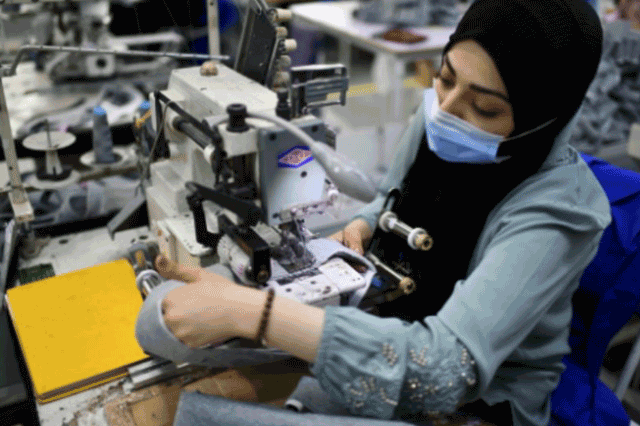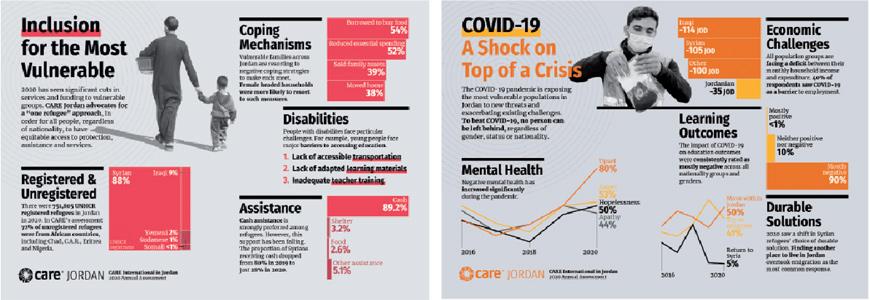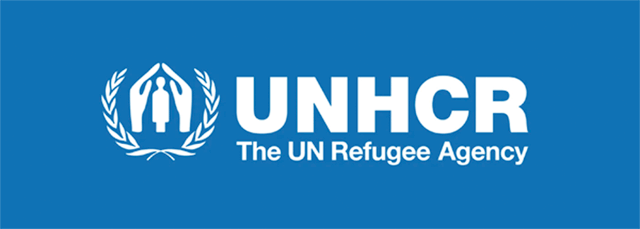You are here
Furthering refugee education an ‘imminent need’, says UNHCR report
By Mays Ibrahim Mustafa - Jun 04,2023 - Last updated at Jun 04,2023

Marwa is a 23-year-old Syrian refugee living in Irbid. She graduated from fashion and textile programme from Luminus Technical University College (Photo courtesy of UNHCR/Mohammad Hawari)
AMMAN — A survey recently published by the United Nations High Commissioner for Refugees (UNHCR) revealed that only 13 per cent of Syrian refugees, and 25 per cent of non-Syrian refugees, carry a university degree.
The survey, titled “Pathways to Employment”, noted that there is an “imminent need” to build the capacities of refugees and further their education to improve their employment prospects, “whether formally through re-integration into the formal education systems, or informally through alternative education”.
The report recommended expanding vocational training programmes in alignment with the local and global labour market, in addition to conducting research to determine “in-demand sectors”.
Additional training is needed to enhance refugees’ language skills, as the survey results showed that 70 per cent of Syrian refugees, and 33 per cent of non-Syrian refugees, speak “poor to basic English”.
The findings of the survey, which was conducted remotely in August 2022, are based on the responses of 16,032 refugees, 84 per cent, or 13,512 of whom are from Syria. The survey also gathered responses from 1,188 refugees from Iraq, 708 from Yemen and 515 from Sudan, while the remaining 109 are from other countries, according to the report.
Education levels
The survey showed that 27 per cent Syrian respondents reported primary school as their highest level of education, followed by middle school, which includes grades 7, 8 and 9, at 26 per cent of respondents.
Other Syrian respondents reported “high school (23 per cent), university (13 per cent), no education (5 per cent), technical and vocational (3 per cent), post university and informal education (1 per cent each),” the report stated.
As for respondents of other nationalities, 33 per cent reported high school as their highest level of education, while 25 per cent attended university. Of the non-Syrian refugee respondents, 18 per cent only reached middle school, followed by “primary school (11 per cent), technical and vocational trainings (5 per cent), post school (1 per cent) and no education (1 per cent)”, according to the report.
Vocational training
A third of Syrian refugee respondents have taken vocational training (VT) in the past, 80 per cent of whom have done so in Jordan. The report also showed that 65 per cent of these respondents have a certificate of their training.
The most popular VT areas for women include beauty studies (29 per cent), and tailoring, followed by sweet making, English language and IT (10 per cent), the report stated.
The most common VT trainings for men include painting (16 per cent), followed by electrical training, IT, and English language and carpentry (11 per cent each), it stated.
Additionally, 37 per cent of surveyed non-Syrian refugees have taken VT courses in the past, of whom 57 per cent have done so in Jordan, and 69 per cent have a certificate of their VT.
The most popular VT areas among non-Syrian refugee women were English language (24 per cent), followed by beauty studies, tailoring, sweet making, and IT and healthcare (16 per cent each), it stated.
Among men, the popular fields were electrical training (19 per cent), IT, English language, sweet making, and mobile maintenance and barbers (7 per cent each), the report added.
Employment
One quarter of the Syrian respondents reported that they are currently working, only 43 per cent of whom hold a work permit, the survey revealed.
The UNHCR report also indicated that Syrian refugee women’s employment rate stood at 7 per cent, while that of their male counterparts reached 33 per cent.
Among non-Syrian refugees, “90 per cent of male and 96 per cent of female respondents reported that they are currently not working”, the report added.
Some 32 per cent of non-Syrian respondents and 37 per cent of Syrian respondents reported having “a health condition that requires special working conditions”, the report stated.
Moreover, it noted that despite the low “current” employment rate, the overwhelming majority of all respondents, both male and female, reported having previous work experience.
Home-based businesses
The report pointed out that only 4 per cent of Syrian respondents said that they were running a home-based business (HBB), of whom only 11 per cent had fully registered and licensed their HBB.
Moreover, it showed that roughly 3 per cent of non-Syrian respondents reported running HBB that are “neither registered nor licensed”.
Recommendations
Recommendations stemming from the survey were divided into four points. The first was titled, “Advocacy with the Government of Jordan”, followed by “Capacity Building”, “Addressing the Gaps” and “Expanding Access to Complementary Pathways, especially Third Country Employment Opportunities”.
Aside from capacity building, the report recommended advocacy with the government to ensure equal access to work for both Syrian and non-Syrian refugees.
It also highlighted the need to increase efforts “towards re-certification and equivalency”, in addition to advocating for adjustments in the workplace to accommodate refugees who need “special working conditions”.
“[S]tronger advocacy on the inclusion of nuclear family members within third country employment pathways is needed, taking into consideration the portion of refugees unable to travel without their dependent/nuclear family members,” it added.
Investing in awareness-raising efforts on “Complementary Pathways, especially third country employment pathways” is also essential, according to the report.
“The results of the survey have indicated a wide interest in third country employment opportunities; however, it also showed a lack of awareness on Labour Mobility partners and opportunities,” the report stated.
Related Articles
AMMAN — Of the more than 87,000 registered refugees or asylum seekers of non-Syrian nationalities in Jordan, many struggle to obtain humanit
AMMAN — The COVID-19 pandemic has had a profound impact on Jordan’s most vulnerable population during 2020 and has exposed them to new chall
AMMAN — Syrian refugee households in Jordan reported a decrease in their average monthly income in the first quarter (Q1) of 2023, according

















